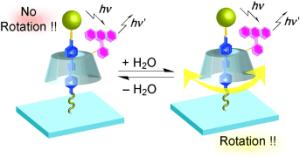|
Related Topics: |
|
Current News |
|
Chemistry A to Z |
|
About Internetchemistry |
|
- Imprint |
|
|
Molecular Hula Hoop |
|
Humans have long been trying to make the dream of nanoscopic robots come true. The dream is, in fact, taking on some aspects of reality. Nanoscience has produced components for molecular-scale machines. One such device is a rotor, a movable component that rotates around an axis. Trying to observe such rotational motion on the molecular scale is an extremely difficult undertaking. Japanese researchers at the Universities of Osaka and Kyoto have now met this challenge. As Akira Harada and his team report in the journal Angewandte Chemie, they were able to get “snapshots” of individual molecular rotors caught in motion. |
|
As the subject of their study the researchers chose a rotaxane. This is a two-part molecular system: A rod-shaped molecule is threaded by a second, ring-shaped molecule like a cuff while a stopper at the end of the rod prevents the ring from coming off. The researchers attached one end of the rod to a glass support. To observe the rotational motions of the cuff around the sleeve, the scientists attached a fluorescing side chain to the cuff as a probe. To observe the rotation of the ring around the rod, the researchers used a microscopic technique called defocused wide-field total internal reflection fluorescence microscopy. This gave snapshots of individual rotaxane molecules in the form of emission patterns. In simplified terms, if the cuff is motionless, the patterns make it possible to calculate the direction in which the probe emits its fluorescent light. This makes it possible to calculate the orientation of the cuff, which remains constant for every snapshot. However, if the cuff is rotating, the emission pattern does not reveal the spatial orientation of the probe. The researchers showed that the cuff of the rotaxane does not rotate if the sample is dry. However, when it is wet they can see very rapid rotational and vibrational motion. The cuff rotates faster than the time required to snap a picture: the rotational speed is thus over 360° in 300 milliseconds. |
|
|
|
|
Related topics - search form: |
|
|
